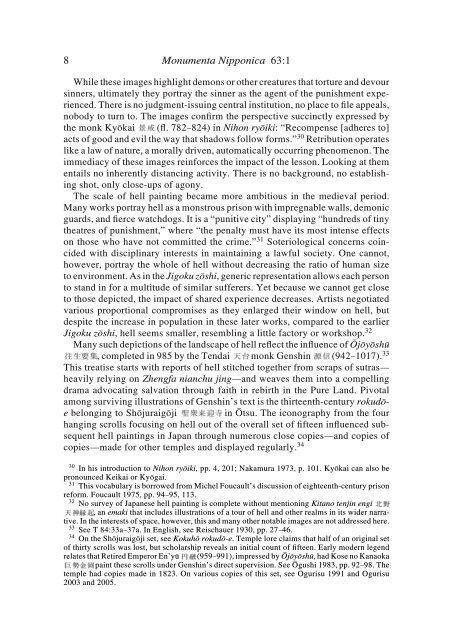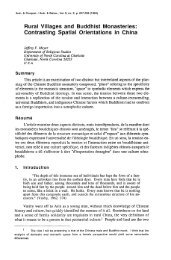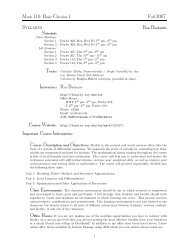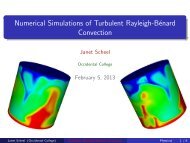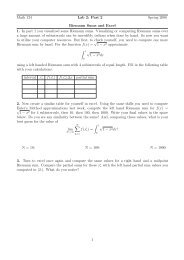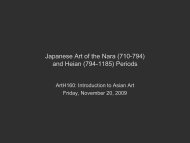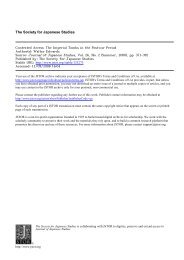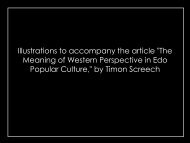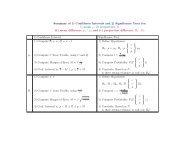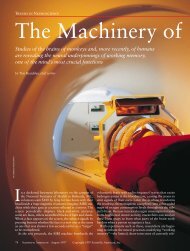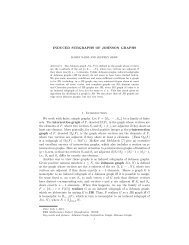A Primer on Japanese Hell Imagery and Imagination - Occidental ...
A Primer on Japanese Hell Imagery and Imagination - Occidental ...
A Primer on Japanese Hell Imagery and Imagination - Occidental ...
You also want an ePaper? Increase the reach of your titles
YUMPU automatically turns print PDFs into web optimized ePapers that Google loves.
8<br />
M<strong>on</strong>umenta Nipp<strong>on</strong>ica 63:1<br />
While these images highlight dem<strong>on</strong>s or other creatures that torture <strong>and</strong> devour<br />
sinners, ultimately they portray the sinner as the agent of the punishment experienced.<br />
There is no judgment-issuing central instituti<strong>on</strong>, no place to file appeals,<br />
nobody to turn to. The images c<strong>on</strong>firm the perspective succinctly expressed by<br />
the m<strong>on</strong>k Kyôkai (fl. 782–824) in Nih<strong>on</strong> ryôiki: “Recompense [adheres to]<br />
acts of good <strong>and</strong> evil the way that shadows follow forms.” 30 Retributi<strong>on</strong> operates<br />
like a law of nature, a morally driven, automatically occurring phenomen<strong>on</strong>. The<br />
immediacy of these images reinforces the impact of the less<strong>on</strong>. Looking at them<br />
entails no inherently distancing activity. There is no background, no establishing<br />
shot, <strong>on</strong>ly close-ups of ag<strong>on</strong>y.<br />
The scale of hell painting became more ambitious in the medieval period.<br />
Many works portray hell as a m<strong>on</strong>strous pris<strong>on</strong> with impregnable walls, dem<strong>on</strong>ic<br />
guards, <strong>and</strong> fierce watchdogs. It is a “punitive city” displaying “hundreds of tiny<br />
theatres of punishment,” where “the penalty must have its most intense effects<br />
<strong>on</strong> those who have not committed the crime.” 31 Soteriological c<strong>on</strong>cerns coincided<br />
with disciplinary interests in maintaining a lawful society. One cannot,<br />
however, portray the whole of hell without decreasing the ratio of human size<br />
to envir<strong>on</strong>ment. As in the Jigoku zôshi, generic representati<strong>on</strong> allows each pers<strong>on</strong><br />
to st<strong>and</strong> in for a multitude of similar sufferers. Yet because we cannot get close<br />
to those depicted, the impact of shared experience decreases. Artists negotiated<br />
various proporti<strong>on</strong>al compromises as they enlarged their window <strong>on</strong> hell, but<br />
despite the increase in populati<strong>on</strong> in these later works, compared to the earlier<br />
Jigoku zôshi, hell seems smaller, resembling a little factory or workshop. 32<br />
Many such depicti<strong>on</strong>s of the l<strong>and</strong>scape of hell reflect the influence of Ôjôyôshû<br />
, completed in 985 by the Tendai m<strong>on</strong>k Genshin (942–1017). 33<br />
This treatise starts with reports of hell stitched together from scraps of sutras—<br />
heavily relying <strong>on</strong> Zhengfa nianchu jing—<strong>and</strong> weaves them into a compelling<br />
drama advocating salvati<strong>on</strong> through faith in rebirth in the Pure L<strong>and</strong>. Pivotal<br />
am<strong>on</strong>g surviving illustrati<strong>on</strong>s of Genshin’s text is the thirteenth-century rokudôe<br />
bel<strong>on</strong>ging to Shôjuraigôji in Ôtsu. The ic<strong>on</strong>ography from the four<br />
hanging scrolls focusing <strong>on</strong> hell out of the overall set of fifteen influenced subsequent<br />
hell paintings in Japan through numerous close copies—<strong>and</strong> copies of<br />
copies—made for other temples <strong>and</strong> displayed regularly. 34<br />
30 In his introducti<strong>on</strong> to Nih<strong>on</strong> ryôiki, pp. 4, 201; Nakamura 1973, p. 101. Kyôkai can also be<br />
pr<strong>on</strong>ounced Keikai or Kyôgai.<br />
31 This vocabulary is borrowed from Michel Foucault’s discussi<strong>on</strong> of eighteenth-century pris<strong>on</strong><br />
reform. Foucault 1975, pp. 94–95, 113.<br />
32 No survey of <strong>Japanese</strong> hell painting is complete without menti<strong>on</strong>ing Kitano tenjin engi<br />
, an emaki that includes illustrati<strong>on</strong>s of a tour of hell <strong>and</strong> other realms in its wider narrative.<br />
In the interests of space, however, this <strong>and</strong> many other notable images are not addressed here.<br />
33 See T 84:33a–37a. In English, see Reischauer 1930, pp. 27–46.<br />
34 On the Shôjuraigôji set, see Kokuhô rokudô-e. Temple lore claims that half of an original set<br />
of thirty scrolls was lost, but scholarship reveals an initial count of fifteen. Early modern legend<br />
relates that Retired Emperor En’yû (959–991), impressed by Ôjôyôshû, had Kose no Kanaoka<br />
paint these scrolls under Genshin’s direct supervisi<strong>on</strong>. See Ôgushi 1983, pp. 92–98. The<br />
temple had copies made in 1823. On various copies of this set, see Ogurisu 1991 <strong>and</strong> Ogurisu<br />
2003 <strong>and</strong> 2005.


